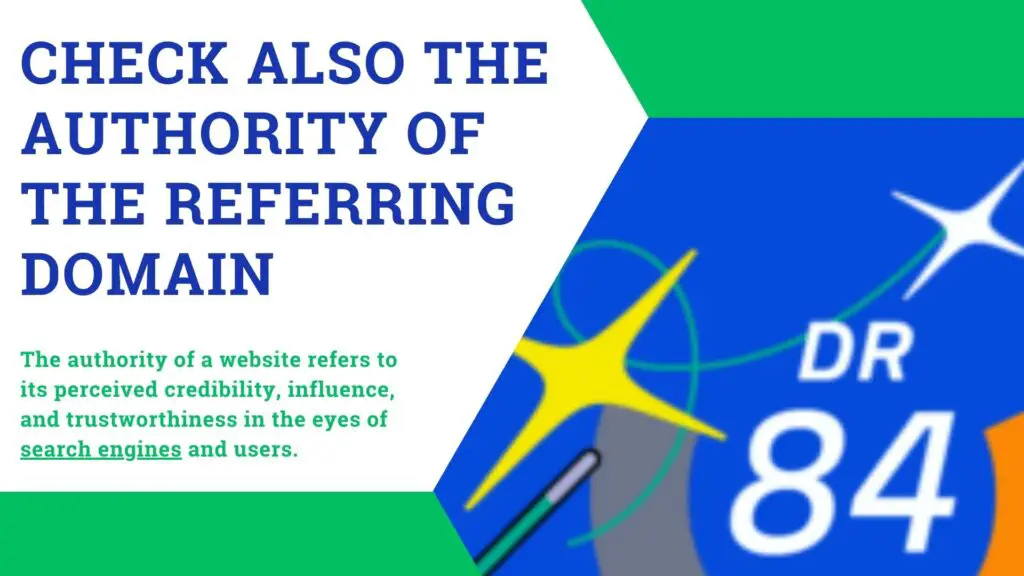According to Google, a quality backlink is one that meets certain criteria and is considered valuable for SEO purposes. Google’s algorithm takes into account various factors when evaluating the quality of backlinks to determine the authority and relevance of a website.
However, not all backlinks are created equal. To ensure the effectiveness and safety of your link-building efforts, it’s important to evaluate the quality of backlinks.
In this article, we will explore seven essential factors to consider when checking backlink quality.
1. You Must Check the Relevance of the Link

Relevance is a key aspect when assessing backlink quality. When checking the relevance of a backlink, it’s important to consider several factors to ensure that the link comes from a website or page that aligns with your own website’s topic or theme.
Here’s a detailed expansion of each step to evaluate relevance:
Analyze the content
Start by thoroughly examining the content of the linked page. It should cover topics and subject matter that are related to your website’s niche or industry.
Look for keywords, phrases, and overall thematic relevance. Ask yourself if the linked page provides valuable and complementary information to your own content.
Check the anchor text
The anchor text is the clickable text that forms the hyperlink. It should accurately represent the content of the linked page.
The anchor text should ideally include relevant keywords or phrases that indicate the topic or theme of the page it is linking to.
Make sure the anchor text provides a clear and concise description of what users can expect when they click on the link.
Assess the surrounding context
The placement of the backlink within the content is crucial for assessing relevance. The link should be placed within relevant paragraphs or sections of the content where it naturally fits.
It should contribute to the overall flow and context of the information being presented.
When the link is surrounded by related content, it reinforces the connection between the linked page and your own website.
2. Check Also the Authority of the Referring Domain

The authority of a website refers to its perceived credibility, influence, and trustworthiness in the eyes of search engines and users.
It is a measure of how much weight and value a website carries in terms of its content, backlink profile, user engagement, and overall online presence.
The authority of the referring domain can significantly impact the value of a backlink.
When evaluating the authority of the referring domain, there are several factors to consider. Here are some details to expand upon the points mentioned:
a-Use SEO tools
There are a number of SEO tools that can be used to gauge the authority of a domain.
Some popular tools include Moz’s Domain Authority, Ahrefs’ Domain Rating, and Majestic’s Trust Flow.
These tools use a variety of factors to calculate domain authority, including the number of backlinks, the quality of those backlinks, and the age of the domain.
b-look at the backlink profile
The backlink profile of a domain is a good indicator of its authority. A domain with a high-quality backlink profile will have backlinks from other authoritative websites.
The anchor text of these backlinks should also be relevant to the domain’s content.
c-Consider the type of website
The type of website that is linking to yours can also impact the value of the backlink. For example, a backlink from a news website will be more valuable than a backlink from a forum.
d-Check the age of the domain
Older domains often have accumulated more authority over time. This is because they have had more time to build up backlinks and to establish themselves as authoritative sources of information.
However, it is important to note that domain age is not the only factor that determines domain authority. A newer domain can still have high authority if it has a high-quality backlink profile.
e-Look at the number of backlinks
The number of backlinks that a domain has is also a factor. However, it is important to note that the quality of the backlinks is more important than the quantity.
f-Check the freshness of the backlinks
The freshness of the backlinks is also important. Backlinks that are recent are more valuable than backlinks that are old.
By following these tips, you can evaluate the authority of the referring domain and ensure that you are getting high-quality backlinks.
3. Check the Traffic of the Referring Domain

The traffic of a domain refers to the number of visitors or users that a website receives within a given period. It is a measure of the popularity and engagement of a website and can provide insights into its reach and influence.
Checking the traffic of a domain can help you assess its performance, compare it with competitors, and make informed decisions regarding partnerships, advertising, or SEO strategies.
There are several methods and tools available to check the traffic of a domain. Here are a few commonly used approaches:
a-Web Analytics Tools
The most accurate and detailed way to check domain traffic is by using web analytics tools. Google Analytics is one of the most popular and widely used analytics platforms.
By integrating a tracking code into a website, it provides comprehensive data on visitor demographics, traffic sources, engagement metrics, and more.
Other analytics tools, such as Adobe Analytics and Matomo, offer similar capabilities.
b-Third-Party Traffic Estimation Tools
Several third-party tools provide estimates of a domain’s traffic based on various data sources and algorithms.
While these estimates are not as precise as web analytics data, they can still offer valuable insights. Examples of such tools include SimilarWeb, Alexa, and SEMrush.
These tools provide estimations of a website’s traffic volume, sources of traffic, user engagement metrics, and even demographic information.
c-Search Engine Console
If you have verified ownership of a website in Google Search Console or Bing Webmaster Tools, you can access valuable data about the organic search traffic to your domain.
These tools provide information on the number of impressions, clicks, and average search position for specific keywords.
While this data focuses on organic search traffic, it can be helpful in understanding how search engines perceive your domain’s visibility.
d-Competitor Analysis Tools
Some tools, like SEMrush and Ahrefs, offer competitive analysis features that allow you to compare the traffic of multiple domains.
By entering the domain of interest and its competitors, you can obtain an overview of traffic metrics, search rankings, and backlink profiles.
This can help you gauge the relative popularity and performance of different domains in your industry.
It’s important to note that traffic estimation tools may have limitations and variations in their data. They rely on different data sources and algorithms, and their estimates may not always align perfectly with actual traffic numbers.
However, they can still provide valuable directional insights and comparative analysis.
4. Check the Trustworthiness of the Referring Domain

When assessing the trustworthiness of a referring domain, it is essential to consider several factors that can indicate the credibility and reliability of the website. Here are further details on evaluating the trustworthiness of a referring domain:
- Evaluate the website’s design and user experience: A well-designed website with a clean layout, intuitive navigation, and a professional appearance can create a positive impression on visitors. A user-friendly site that provides a seamless browsing experience is often associated with trustworthiness. A poorly designed website, on the other hand, may raise doubts about the legitimacy and professionalism of the domain.
- Look for security measures: Website security is a critical aspect of trustworthiness. Check if the referring domain uses HTTPS encryption, which ensures that data transmitted between the user’s browser and the website remains secure. Secure websites display a padlock icon in the browser’s address bar, indicating a secure connection.
- Consider the website’s reputation: To assess the reputation of the referring domain, it’s important to conduct thorough research. Look for any negative reviews or complaints about the website. Online forums, review platforms, and social media can provide insights into user experiences and opinions.
5. Check the Anchor Text of the Link

The anchor text of a link refers to the visible, clickable text that users see when they encounter a hyperlink on a webpage. It serves as a descriptive label for the linked content and provides context about the destination of the link.
Anchor text plays a role in SEO as search engines use it to understand the relevance and topic of the linked page.
Checking the anchor text of a link can be done by following these steps:
- Inspect the HTML source code: Right-click on the webpage containing the link and select “Inspect” or “Inspect Element” (depending on the browser). This will open the browser’s developer tools.
- Locate the link: In the developer tools, use the element inspector to find the specific HTML code representing the link. It is typically denoted by the <a> tag.
- Examine the anchor text: Within the <a> tag, look for the attribute href, which contains the URL of the destination page. The anchor text is the text enclosed between the opening <a> tag and the closing </a> tag.
6. Check the Contextuality of the Link

The context of a link refers to the surrounding content and the relevance of the link within that content.
It involves understanding how the link is placed, the content it is embedded in, and whether the link adds value to the overall context.
Checking the context of a link is important to ensure its quality and relevance. Here’s how you can check the context of a link:
a-Read the surrounding content
Carefully examine the text or the section of the content where the link is placed. Determine if the linked content is related to the topic being discussed.
Assess whether the link provides additional information, supports the main point, or adds value to the overall content.
A link that fits naturally within the context and enhances the reader’s understanding is more likely to be of higher quality.
b-Evaluate the placement of the link
Consider where the link is located within the content. Links placed within the body of the content are generally considered more valuable than those in sidebars, footers, or author bios.
Content that includes contextual links within relevant paragraphs or sections indicates a stronger connection between the linked and linking pages.
c-Assess the relevance of the linked page
Click on the link and visit the linked page. Analyze the content of the linked page to ensure it aligns with the anchor text and the overall topic of the referring page.
The linked page should provide valuable and relevant information to the readers.
If the linked page is unrelated or lacks relevance to the referring page’s content, it may indicate a lower-quality link.
d-Check for link co-citations
Explore the referring page and the linked page for any additional references or mentions of your website within the same context.
If the linked page includes other references to your website or if your website is mentioned as a source of information, it can further validate the importance and relevance of the link within the context.
7. Check the Diversity of the Link Profile

A link profile is a collection of all the backlinks that point to a website. These backlinks can come from a variety of sources, including other websites, social media platforms, and directories. The diversity of a link profile refers to the variety of sources of these links.
A diverse link profile is important for SEO because it shows Google that your website is being referenced and linked to by a wide range of sources. This can be seen as a sign of credibility and authority in the eyes of search engines.
There are a number of ways to check the diversity of a link profile. One way is to use an SEO tool like Ahrefs or Moz. These tools will allow you to see the number of backlinks from different sources, as well as the anchor text of the links.
Another way to check the diversity of a link profile is to manually review the backlinks. This can be time-consuming, but it can give you a more detailed understanding of the sources of your backlinks.
Examples of different link profiles
- A diverse link profile: This would be a link profile that has backlinks from a variety of sources, including different websites, social media platforms, and directories. The anchor text of the links would also be varied.
- A non-diverse link profile: This would be a link profile that has backlinks from a limited number of sources. The anchor text of the links would also be limited.
Conclusion
Evaluating backlink quality is a critical step in any SEO strategy. By considering the relevance of the link, the authority and traffic of the referring domain, the trustworthiness of the domain, the anchor text, the context of the link, and the diversity of the link profile, you can make informed decisions about which backlinks to prioritize.
Remember, building a high-quality and diverse backlink profile is key to enhancing your website’s visibility, authority, and organic search rankings.
